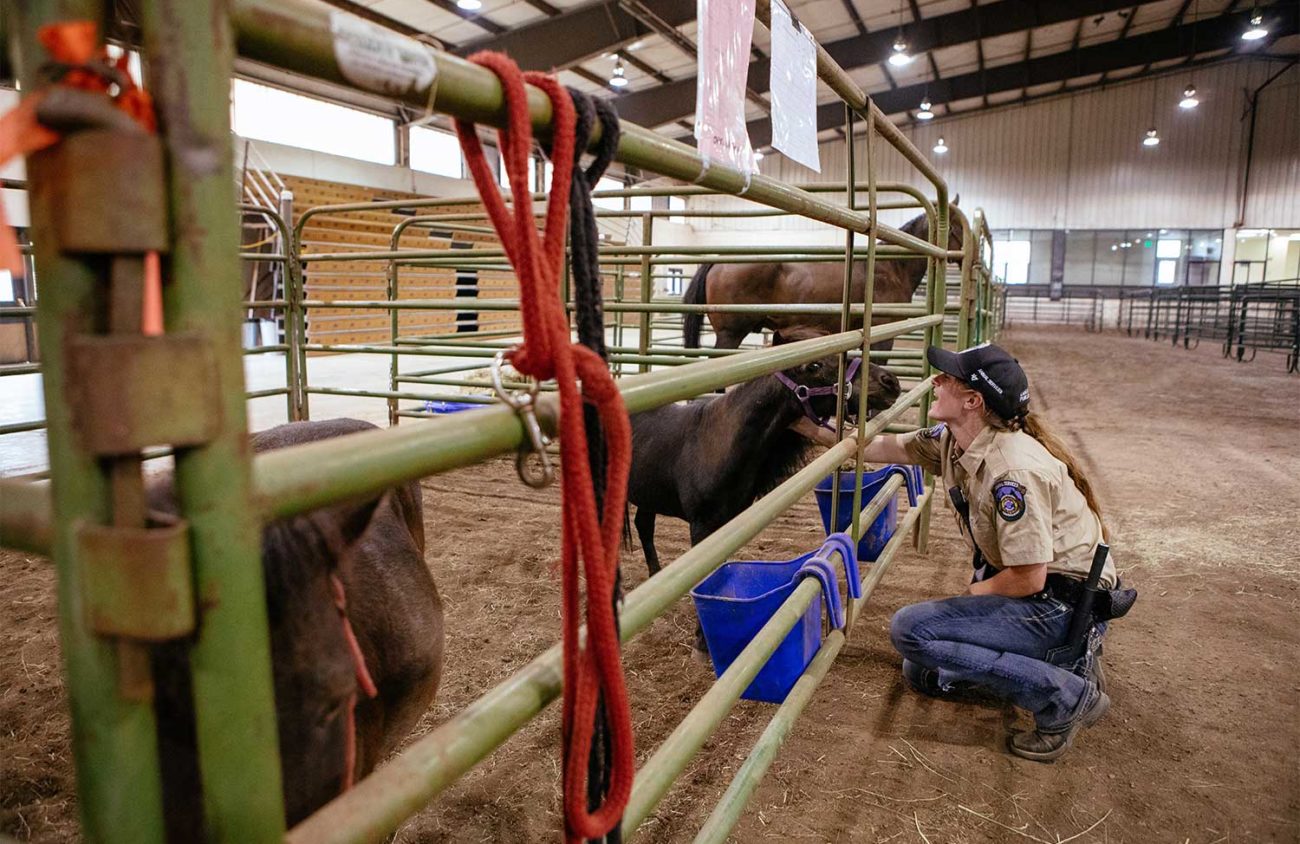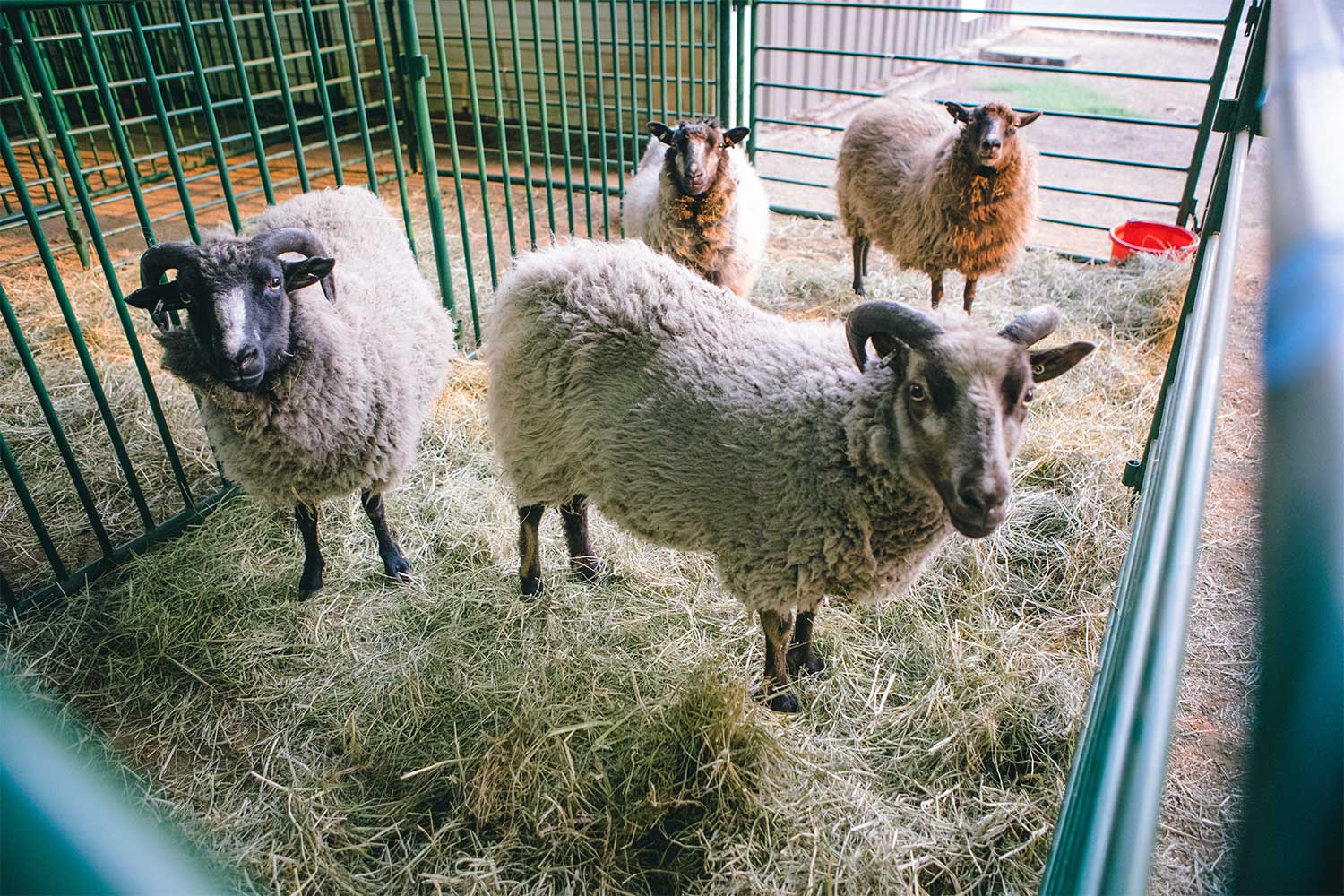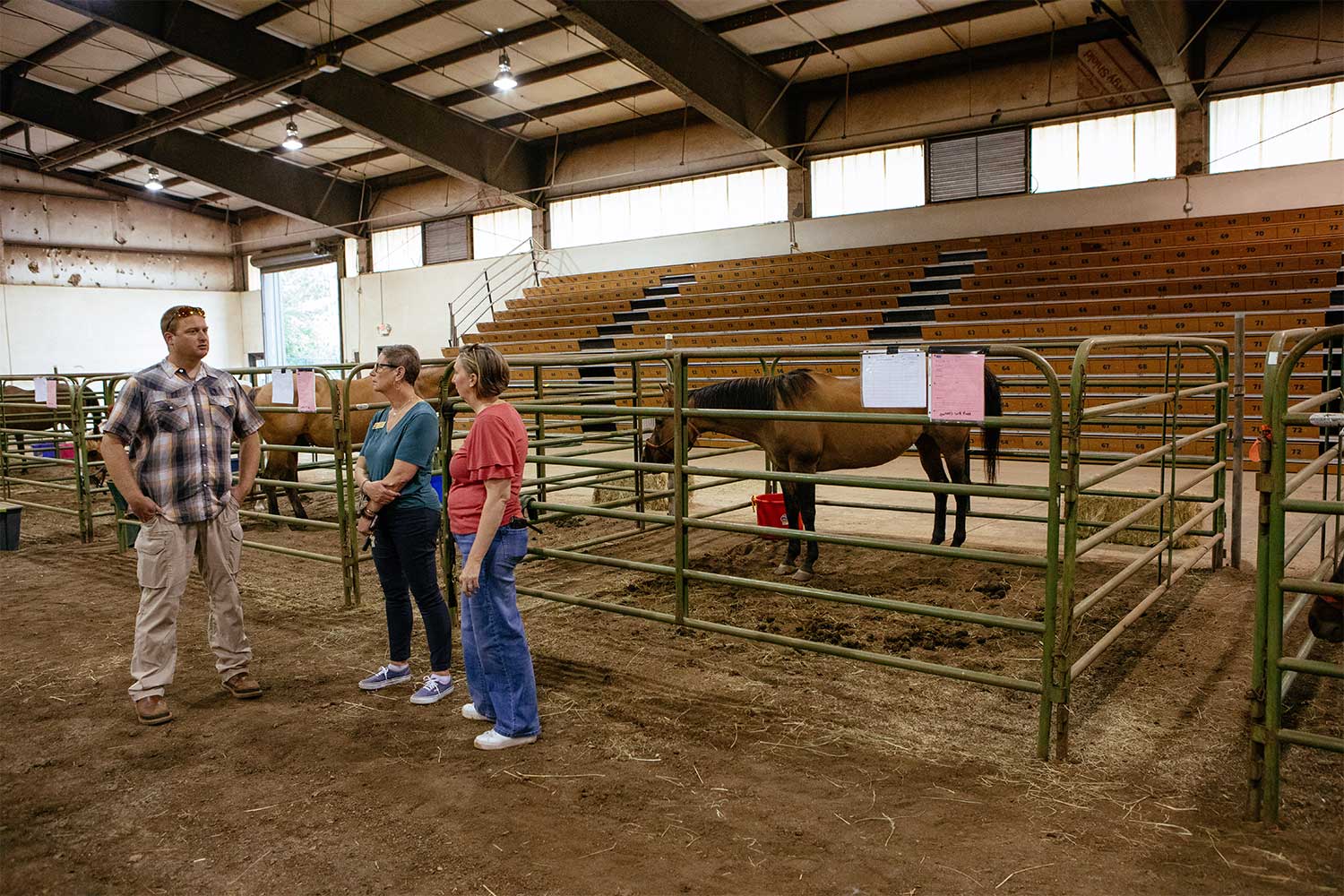Under a smoke-filled sky at the Lane Events Center, children throw a football on a patch of grass, Greenhill Humane Society volunteers walk small dogs and a few hundred feet away the horse arena houses scores of livestock.
In one day, the Cedar Creek Fire nearly doubled its size — going from from 33,099 acres on Sept. 8 to 51,814 acres on Sept. 9. It now stands at 92,548 acres with 0 percent containment.
The wildfire that began August 1 with lightning strikes in the Willamette National Forest threatened Oakridge and Westfir when dry weather and east winds both blew it up and toward the mountain communities, sparking red flag warnings and then evacuations on Friday, Sept. 9.
With past wildfires to have learned from, including the devastating 2020 Holiday Farm Fire and the 2021 Kwis Fire that threatened Oakridge, Lane County’s operations for transporting livestock have become smoother, says spokesperson Devon Ashbridge.
The Lane Events Center wasn’t the only refuge for animals affected by hazardous air quality and the threat of wildfire. Emily Honey, a volunteer who helped some residents transport livestock, says area barns offered space to reduce the volume of animals at the fairgrounds, as well as offered places for livestock that can’t shelter in close quarters.
Enlarge

Because climate change means wildfires will reoccur in Oregon, Honey says she hopes Lane County government will implement some changes to make animal evacuations easier.
Hours before the Cedar Creek Fire grew, Lane County government opened a large animal evacuation shelter at 8 am that Friday when there was a Level One “be ready” evacuation notice for the residents. And right away people were calling to reserve space.
“About five minutes after we got here, we had a call that we had five horses on the way within the hour,” says Lane County Animal Welfare Officer Isabel Merritt. “We had about eight horses by 11 am, and I started having poultry, goats and sheep starting to show up.”
On Friday evening, the evacuation level for Oakridge and Westfir was raised to Level Three — go now. By the end of Saturday, Sept. 10, the Lane Events Center, which has a capacity for about 600 animals, had about 100, including horses, goats, chickens and rabbits.
The county recommends that residents evacuate their livestock by Level One (get ready) evacuation notices, but especially by Level Two, says Ashbridge. “There’s often no time during a Level Three, and it can be hard to get trailers on the road,” she says. “We definitely stress with large animals and livestock the earlier you move them the better.”
Level Three notices say to leave immediately and not to stop to collect belongings.
Response to the Cedar Creek Fire for livestock evacuation has operated differently than the Holiday Farm Fire, Ashbridge says. “We’ve also built relationships with the livestock owners in Oakridge because we went through a similar situation last year,” she says of the Kwis Fire. “We’re able to get this up and running much more quickly.”
The biggest difference from Holiday Farm, Ashbridge says, is how much notice residents had. “That was not an option for the vast majority of people evacuated from the Holiday Farm Fire. That fire began at night and moved quickly,“ she says. “It’s been really wonderful to see the folks from Oakridge understand that they’ve been given this gift of time and take advantage of it to move their stock.”
Not all animals were transported to the Lane Events Center. When red flag warnings were issued over the dry winds, Honey, who trains horses out of Pleasant Hill, 31 miles from Oakridge, says she filled water buckets and hooked up her truck and trailer.
“Pretty much everyone was pretty traumatized by the 2020 fires,” she says. “The biggest difference from 2020 to now is the majority of people had plans, and we were planning way earlier.”
Honey also turned on notifications for her horse-related Facebook groups where evacuees and hosts can connect, such as Cowgirl 911, which sprang up when the 2020 Labor Day fires forced evacuations all over Oregon. She says someone will post that they have a field where an evacuated animal can be moved to or where someone can ask for help in transportation.
Ashbridge says that ideally evacuees would bring their animals to Lane Events Center or coordinate with family and friends. Those who didn’t have any means to move the livestock could call the county’s Animal Services, which would then relocate the animals through volunteer assistance, such as Lane County Sheriff’s Mounted Posse.
But sometimes it takes time for official rescue groups to get to the livestock owner, Honey says. And the official groups might require contacting the county, for example, through an online form or via phone, a problem if an area doesn’t have power or cell service.
Driving to Oakridge had some difficulties, Honey says. A driver might only have a general notion of where they’re picking up the livestock, and with spotty cell service there’s “an added layer of chaos.”
While in Oakridge, Honey says she encountered some residents who weren’t too concerned about the wildfire. Seeing three horses near the golf course, she asked a couple of men drinking Keystone Light if they needed help. They declined.
In some situations it might actually be best to leave livestock. Moving an animal can be a hard transition, Honey says. “They know they won’t get in a trailer,” she says. “A spooked herd of cattle can jump pretty high.”
Like humans, animals are affected by long term exposure to wildfire. And when evacuating animals, Honey says they have to be provided with extra water and electrolytes and salt licks.
She adds, “A lot of animals will drop weight from breathing in the smoke because they don’t feel good.”
Honey says that transporting livestock to other locations helps avoid overcrowding the fairgrounds, and it helps animals who may not do well in public settings and those whose owners are concerned about the potential for disease.
“The three horses I have, in particular, they’ve never been stalled,” she says of the older horses and a pony she evacuated from Oakridge to her barn. “Putting them in corrals at the events center or stalls where they can’t see their buddies that they’ve been living with for 10 years? Yeah, that’ll really stress them out.”
Ashbridge says that the county estimates about 3,000 people evacuated from Oakridge. The town has a population of about 3,336, according to Census Reporter. If conditions were to be deemed too dangerous, Ashbridge says, the county’s volunteers wouldn’t be able to help them out with livestock transportation.
The barrier to helping someone in that position, Honey says, is in obtaining the necessary paperwork from Lane County government to access the area. In the future, she adds, she hopes the county creates a shortlist of volunteers who have been previously vetted so she wouldn’t have to drive from Pleasant Hill to downtown Eugene and then to Oakridge.
Despite some of the hurdles of traveling to the Oakridge area during the evacuation, Honey says it went smoother than with the 2020 Holiday Farm Fire, as people have become familiar with some of the language and dangers.
“Everyone learned their lesson. We were warned better. We took them more seriously. I think all Oregonians now understand what the red flag warning is,” she says. “I don’t remember getting those when I was a kid, and now I’m like, ‘Oh, shit, I know what that means.’ And I know what I need to do to prep for it.”
For more information on Lane County’s response to the Cedar Creek Fire go to LaneCounty.org/news/cedar_creek_fire_information.



